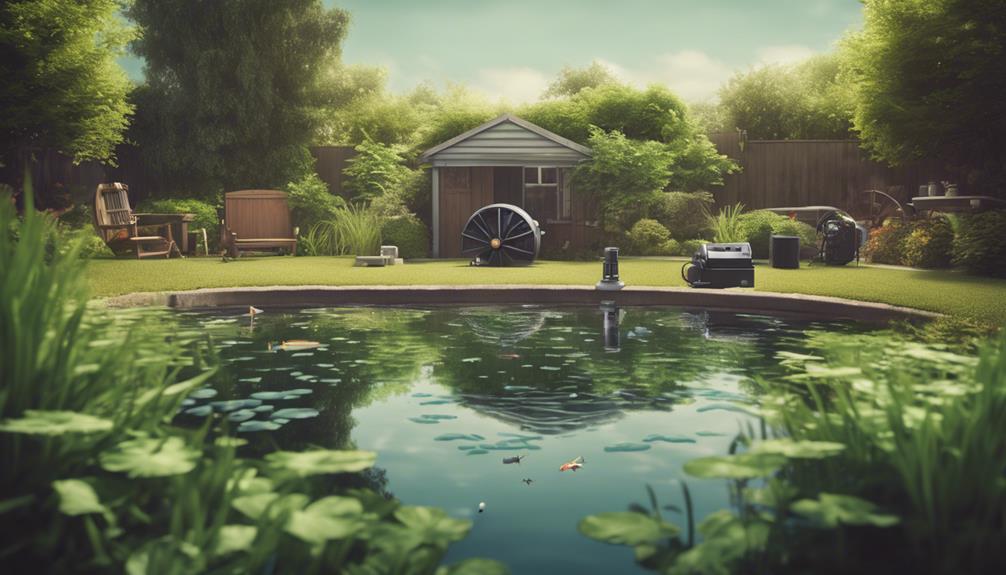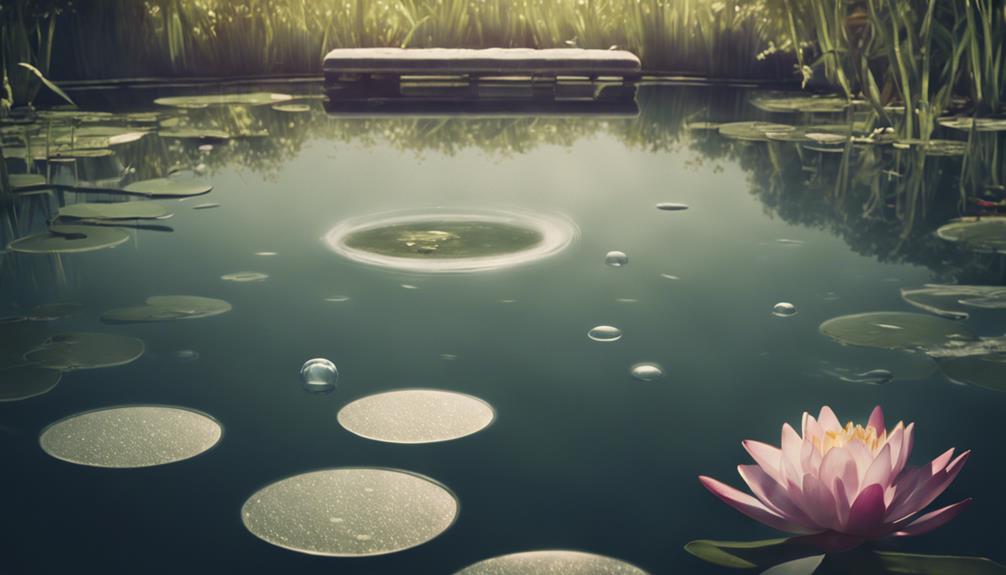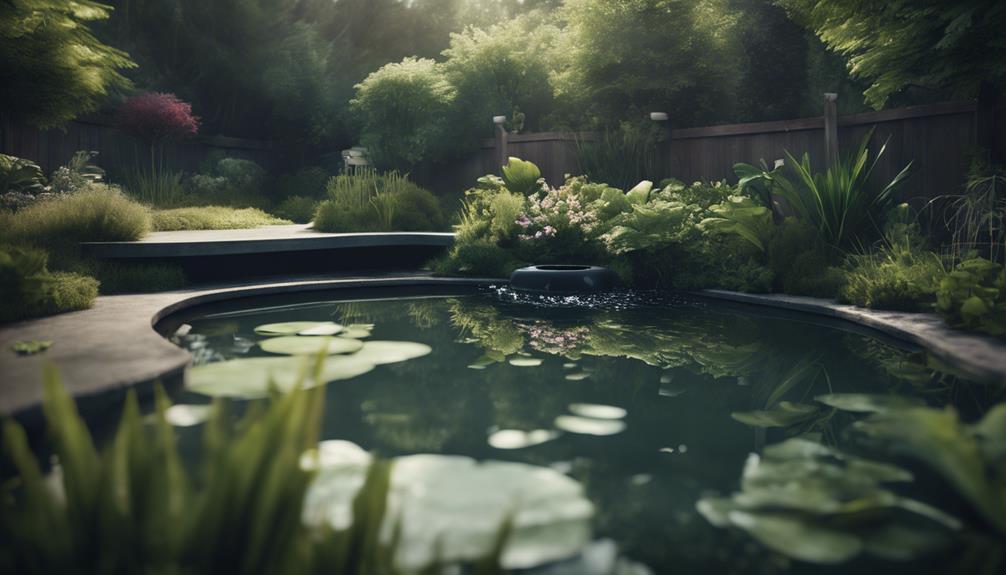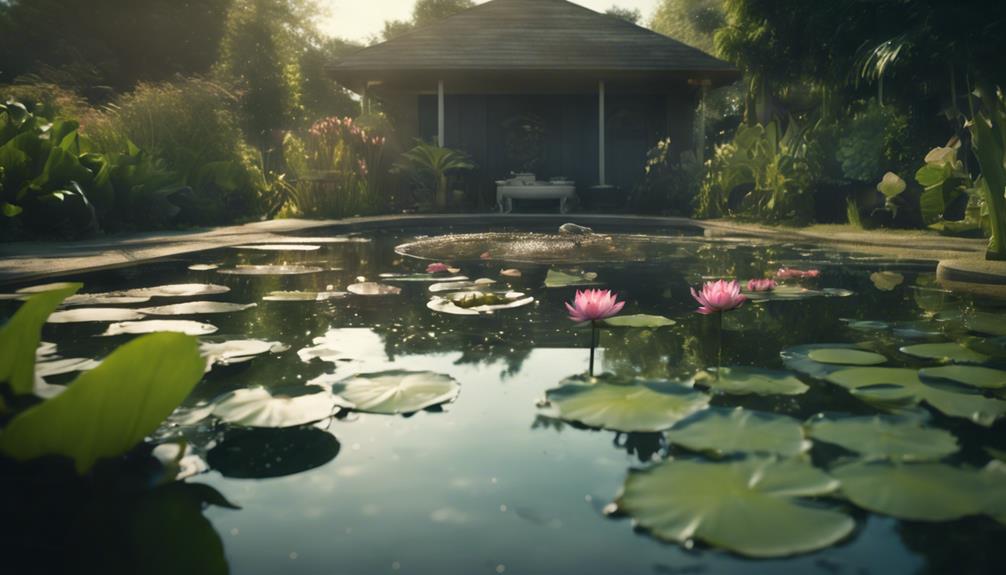You can prevent devastating oxygen deprivation in your backyard pond by incorporating aeration, a vital element for maintaining a healthy environment that supports the well-being of your fish. Without aeration, your pond can quickly become stagnant, leading to low oxygen levels that can cause fish stress, illness, or even death. By installing an aeration system, you'll create a balanced ecosystem, improve water quality and clarity, and increase your pond's fish-holding capacity. To guarantee a thriving pond, you'll want to determine the right aerator for your specific pond needs – and that's just the beginning of creating a healthy haven for your fish.
Table of Contents
Key Takeaways
- Installing an aeration system creates a healthy pond ecosystem that supports a balanced environment for aquatic life.
- Aeration improves water quality and clarity by increasing oxygen levels and preventing stagnation.
- Proper aeration prevents summer and winter fish kills, prolonging a pond's life and ensuring a healthy ecosystem.
- A well-designed aeration system can increase a pond's fish-holding capacity by two times, making it an ideal environment for fish.
- Running an aeration system 24/7 is recommended to maintain a healthy backyard pond and ensure the right amount of oxygen is circulated throughout the water.
Why Aeration Is Necessary
When you neglect to aerate your backyard pond, you're fundamentally suffocating the very life that inhabits it, as oxygen deprivation can have devastating consequences for fish and other aquatic creatures.
Without aeration, your pond can quickly become stagnant, leading to low oxygen levels that can cause fish to become stressed, ill, or even die.
This is because aquatic life relies on dissolved oxygen to breathe, and aeration is necessary to add oxygen to the water.
In a properly aerated pond, oxygen levels remain healthy, and aerobic bacteria can thrive, breaking down organic matter and maintaining a balanced ecosystem.
During hot summer months, aeration is especially vital, as oxygen levels can drop dramatically.
By circulating water and bringing oxygen-rich water to the surface, aeration prevents stagnation and guarantees a healthy environment for your fish to thrive.
By neglecting aeration, you're putting your aquatic friends at risk.
Don't let your pond become a death trap – prioritize aeration to create a thriving habitat where your fish can flourish.
Benefits of Aeration Systems
As you consider implementing an aeration system in your backyard pond, you're likely wondering what benefits it can bring.
By installing an aeration system, you'll be creating a healthy pond ecosystem that supports a balanced environment for aquatic life.
With increased oxygen levels, you'll notice a significant improvement in water quality and clarity.
Healthy Pond Ecosystem
By installing an aeration system, you can create a healthy pond ecosystem where water quality is improved, and aquatic life thrives. A well-designed aeration system can substantially benefit your pond's ecosystem, leading to a cleaner, healthier, and more balanced environment.
| Benefits | Description |
|---|---|
| Improved Water Quality | Aeration prevents stagnation, moving debris towards skimmers, and increasing oxygen levels, resulting in cleaner and healthier water. |
| Increased Aquatic Life | Oxygen-rich water supports the survival of fish, bacteria, and other aquatic life, promoting a balanced ecosystem. |
| Reduced Algae Growth | Aeration slows down eutrophication, reducing algae growth and maintaining a healthy pond environment. |
| Increased Fish-Holding Capacity | Aeration can increase your pond's fish-holding capacity by two times, making it an ideal environment for your fish. |
| Prolonged Pond Life | Aeration prevents summer and winter fish kills, prolonging your pond's life and ensuring a healthy ecosystem.
Increased Oxygen Levels
You can substantially boost the health and resilience of your pond's ecosystem by increasing oxygen levels through aeration, which is vital for the survival and well-being of fish and other aquatic life.
By installing an aeration system, you can add oxygen to your pond, increasing dissolved oxygen levels by up to 30%. This is especially important during hot summer months when oxygen levels naturally decrease.
Aeration systems also help prevent the formation of a thermocline, which can lead to oxygen depletion and stress on fish, reducing the risk of fish kills.
Additionally, increased oxygen levels promote the growth of beneficial bacteria, breaking down organic matter and maintaining a healthy pond ecosystem.
Your fish will also thrive with adequate oxygen levels, experiencing faster growth rates, improved immune systems, and a reduced risk of disease.
Choosing the Right Aerator

When selecting an aerator for your backyard pond, you'll need to weigh the type of aerator that's right for your pond's size and depth, as well as the type of fish you're raising.
You'll also need to design an aeration system that can efficiently distribute oxygen throughout the water, taking into account factors like compressor power and diffuser placement.
Aerator Types
Four primary types of aerators are available for backyard ponds, each designed to address specific water quality and aquatic life needs.
When you're looking to aerate your pond, choosing the right one is crucial to understand the differences between them.
For shallow ponds, surface aeration is a great option. You can use fountains, volcanos, paddle wheels, or PTO-driven agitators to throw water into the air, adding oxygen to the top layer of the pond.
This method is ideal for shallower ponds where a thermocline is less likely to form. However, in deeper ponds, a thermocline can set up, and bottom diffusion aeration systems are more effective.
These systems bring low-oxygen water to the surface to absorb oxygen from the atmosphere, releasing oxygen-rich air into the water. You can opt for grid-based, solar-operated, or windmill or wind-driven systems for bottom diffusion.
For peak results, consider combining surface and bottom aeration methods. By selecting the right aerator type based on your pond's size, depth, shape, and aquatic life, you can create a healthy environment for your fish to thrive.
Aeration System Design
Properly designing an aeration system is crucial to maintaining a healthy backyard pond, as it guarantees the right amount of oxygen is circulated throughout the water.
When choosing the right aerator, you'll want to ponder the size and depth of your pond. A general rule of thumb is to provide 1-2 CFM of airflow per acre of pond surface area. You'll also need to verify the compressor produces enough air to move the required amount of water, taking into account the pond's depth – 0.5 psi is needed to get air to the diffuser for every foot of water depth.
The diffuser should be placed no deeper than 1/3 the total pond depth to facilitate effective oxygenation and water circulation throughout the entire pond.
Aim to move the volume of water in the pond to the surface at least once every 24 hours, with twice being even better for peak oxygenation and water circulation.
Running your aeration system 24/7 is recommended, but it can be run less if the system is large enough. Ponder running it during the hours before and after sunrise when oxygen levels are typically at their lowest.
Surface Aeration Methods
You can effectively introduce oxygen into your pond's water using surface aeration methods, which not only enhance the aesthetic appeal of your backyard oasis but also provide a healthy environment for your aquatic life.
Since fish need oxygen to survive, it's vital to guarantee your pond's surface water has enough oxygen. Surface aeration methods, such as fountains, streams, and waterfalls, create a more significant disruption to the water's surface, allowing more oxygen to dissolve into the water.
This is especially important in shallower ponds where a thermocline is less likely to form. By incorporating surface aeration methods, you can create a healthy environment for your fish, reduce algae growth, and enjoy a more beautiful and peaceful pond.
Fountains, in particular, are a popular choice as they not only add oxygen to the water but also create a visually appealing display. By selecting the right surface aeration method for your pond, you'll be able to provide the necessary oxygen for your fish to thrive.
Sub-Surface Aeration Options

While surface aeration methods can effectively introduce oxygen into your pond's water, sub-surface aeration options offer a more targeted approach to circulating water and increasing oxygen levels, especially in deeper ponds or during warm summer months when oxygen levels are depleted.
As you know, your fish need oxygen to thrive, and sub-surface aeration guarantees they get it. By circulating the water column from the bottom up, you're creating a healthier environment for your fish.
This is especially vital during summer when warm water can't hold as much dissolved oxygen, making it difficult for fish to breathe. A properly installed sub-surface aeration system can move more water for less operating expense than surface aeration systems.
You can choose from grid-based, solar-operated, or windmill-driven systems that suit your pond's needs. Remember to select a compressor that produces enough air to move the required amount of water, taking into account the water depth and pressure needed to get air to the diffuser.
Winter Aeration and Maintenance
During the winter months, your aerator takes on a new role, working to keep a hole open in the ice to allow fish gases to escape and maintain a cleaner, healthier environment.
To facilitate effective winter aeration, you'll need to adjust the placement of your aerator, moving it closer to the top of the pond. This prevents ice formation and maintains water circulation, which is vital for keeping your pond healthy.
Leaving your aerator at the bottom of the pond during winter can harm your fish, so making this seasonal adjustment is imperative.
If you don't have an aerator, you can use a de-icer as an alternative to create a hole in the ice and maintain water circulation.
Proper winter aeration and maintenance are critical for preventing winterkill and guaranteeing a healthy and thriving pond ecosystem year-round.
By taking these steps, you'll be able to keep your pond healthy and thriving, even in the coldest months.
With the right approach to winter aeration, you can rest assured that your fish will stay healthy and happy, and your pond will remain a beautiful and thriving oasis.
Designing an Aeration System

When designing an aeration system, it's crucial to contemplate several key factors to guarantee your pond receives the necessary oxygen levels to support a healthy ecosystem.
You'll want to certify your system moves the volume of water in your pond to the surface at least once every 24 hours, with twice being even better.
This means your compressor should produce enough air to move the required amount of water, taking into account the water depth.
For every foot of water depth, you'll need 0.5 psi to get air to the diffuser.
A good rule of thumb is to place the diffuser no deeper than 1/3 the total pond depth.
Your system should be sized correctly for your pond's size and depth, and be able to produce the required CFM and GPM to move the correct amount of water.
Common Aeration Mistakes
As you set out to design and install your aeration system, it's equally important to be aware of common mistakes that can undermine its effectiveness, guaranteeing you don't inadvertently create more problems than you solve.
When it comes to aerating your pond, there are a few common mistakes to avoid.
Insufficient aeration: Not providing enough oxygen to your pond water can lead to stagnant water, algae and weeds growth, and even fish death. Make sure to calculate your pond's specific aeration needs to keep your pond healthy and thriving.
Inadequate maintenance: Failing to regularly clean and maintain your aeration system can lead to reduced effectiveness and increased maintenance costs. Set a schedule to check and clean your system regularly to keep it running smoothly.
Incorrect placement: Placing your aerator in the wrong location can reduce its effectiveness. Certify your aerator is placed in a way that allows for maximum water circulation and oxygen distribution.
Frequently Asked Questions
Do You Need to Aerate a Pond for Fish?
You're wise to wonder if aerating your pond is necessary; a healthy pond ecosystem relies on it. By improving water circulation, you'll create a thriving fish habitat, making pond maintenance a breeze and ensuring your finned friends flourish.
Is Aeration Good for Fish?
'Like a gust of cool breeze, aeration is a lifesaver for your finned friends, reducing fish stress by boosting oxygen levels, clarifying water, and nurturing aquatic life – it's a game-changer for their survival and your pond's ecosystem.'
How Can I Naturally Oxygenate My Pond?
You can naturally oxygenate your pond by promoting water circulation, incorporating plant oxygenation, installing natural bubblers, or utilizing wind-driven systems, which enhance dissolved oxygen levels and create a thriving environment for your aquatic friends.
Will Aerating My Pond Help With Algae?
Imagine a stagnant pool, where algae reigns supreme. By aerating, you disrupt this kingdom, increasing water circulation patterns that reduce algae growth rates, oxygen depletion zones, and foster beneficial bacteria colonies, ultimately suppressing algae's dominance.
Conclusion
As you gaze out at your thriving backyard pond, remember that beneath the calm surface, a delicate dance is taking place.
Your aerator is the gentle conductor, orchestrating the harmony between water and air, ensuring your fish swim in a symphony of health and liveliness.
Without it, the music would fade, and the pond would become a stagnant pool of stagnation.
By choosing the right aerator and maintenance routine, you're the maestro, bringing life and beauty to your aquatic oasis.

